"Every asset—every stock, bond, and fund—can be tokenized, which will bring about an investment revolution."
This article is based on the speech titled "Real World Asset Practices in an Uncertain World" delivered by Cobo Lily Z. King on June 10, 2025, at the RWA event hosted by JunHe Law Firm in Hong Kong for several brokerage fund stablecoin institutions and family offices.
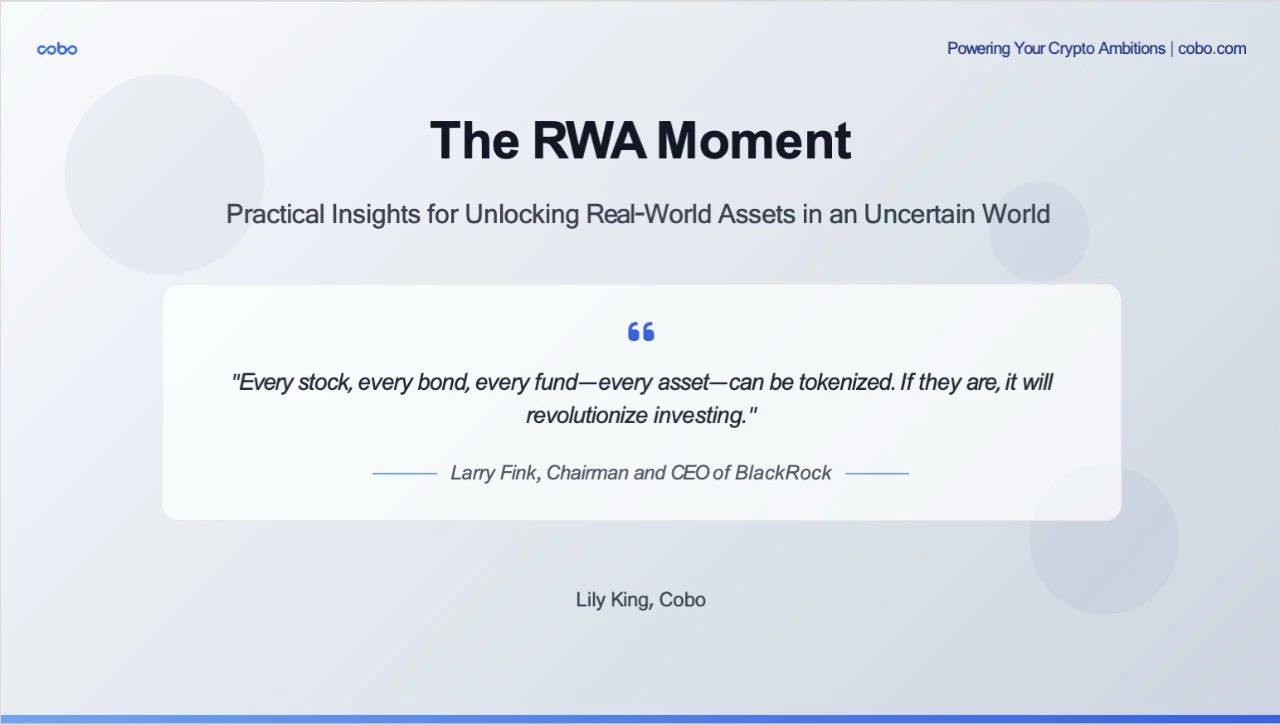
"Every asset—every stock, bond, and fund—can be tokenized, which will bring about an investment revolution." This is a quote from Larry Fink, Chairman and CEO of BlackRock. Larry Fink's vision that everything can be tokenized not only depicts a technological possibility but also heralds a profound transformation in the financial sector. The timing and context in which Larry Fink made this statement are more important than the statement itself. This quote appeared in BlackRock's annual letter to all investors on March 31 of this year. However, in last year's annual letter, terms like stablecoins, RWA, tokenization, and digital assets—some of the most popular words in the market this year—were not mentioned at all, with the only reference to digital assets being the BTC ETF. This year's annual letter from BlackRock is a full-throated call for the financial democratization that tokenization can bring.
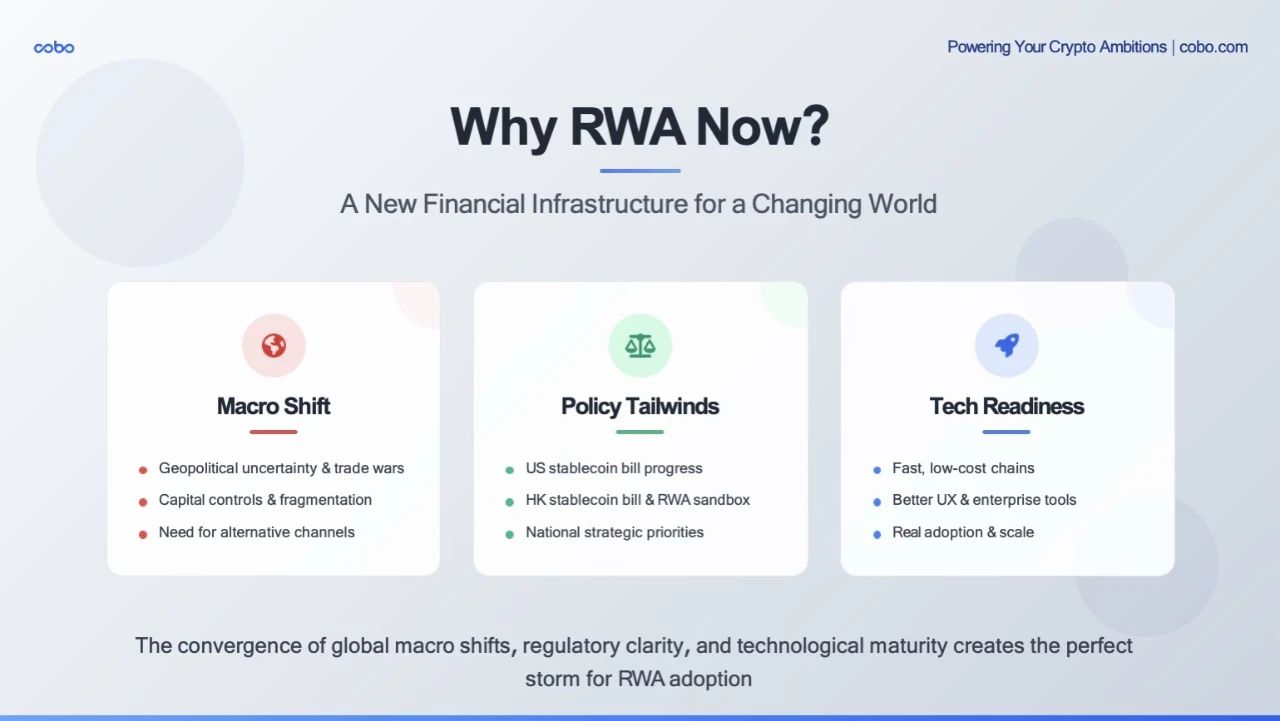
Why have so many big names, including Larry Fink, chosen this moment to discuss Real World Assets (RWA)? Some say it's because DeFi on-chain yields have declined, prompting everyone to seek returns from the real world. Others say that RWA is currently the only hot topic; whoever gets involved sees a rise, whether in coins or stocks. There are also those who recall the RWA craze of 2017-2018, which was then known as ICOs—a trend that swept through. Some argue that there's no need for extensive analysis; if we don't engage with RWA, we might soon find ourselves out of work!
We may need to understand the origins and developments of this RWA trend to make the right choices in the next 6-12 months, allowing RWA to truly take off in Asia and secure a place in the ensuing global competition.
Today, the world is undergoing a significant macro shift. For the first time in decades, we find ourselves in a world filled with geopolitical uncertainty, trade wars, capital controls, and a fragmented—even weaponized—global financial system. While the dollar remains strong, countries are seeking to hedge risks, and cross-border capital flows are facing stricter controls.
In such a context, global capital naturally seeks faster, cheaper, and more open channels for liquidity. At the same time, policies related to digital assets are catching up. Both parties in the U.S. are pushing for stablecoin and tokenization policy frameworks, and in Asia, tokenization is no longer a niche experiment—digital assets have risen to the level of national strategy. Finally, the technological support is gradually maturing. In the past 12 to 18 months, we have seen tremendous progress: transaction fees on Tron, Solana, Base, and various Layer 2 chains are nearly zero, on-chain transaction finality for stablecoins has reached sub-second levels, and the user experience of digital wallets is rapidly improving—such as abstracting gas fees, one-click approvals, and custodial services with institutional-level banking experiences.
So, why is Larry Fink bringing up RWA now? It's not because the hype cycle has arrived, but because the world needs it more than ever—a way and vision to efficiently, compliantly, and globally integrate traditional finance into the future of finance.
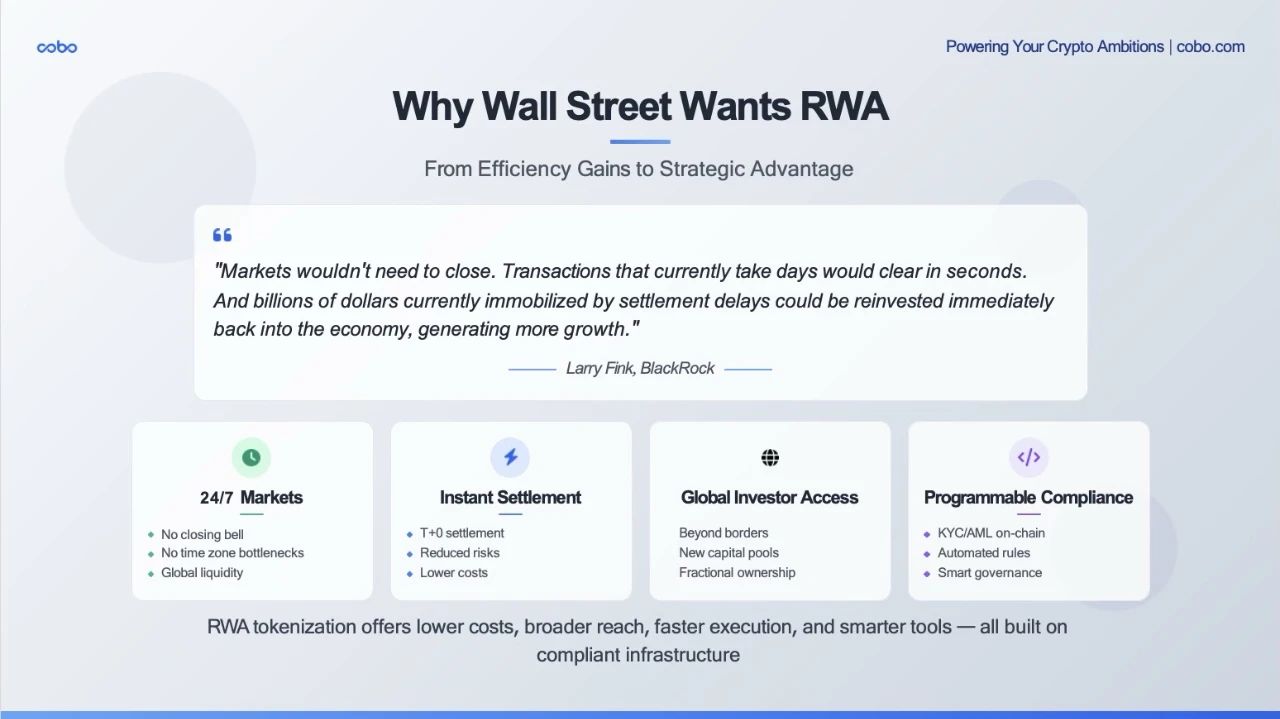
In Larry Fink's view, Wall Street needs to reduce costs and increase efficiency. Simply put, Real World Assets (RWA) can make the market faster, leaner, and more global—without violating existing rules. Wall Street is not about crypto for the sake of crypto, but about improving the infrastructure of existing capital markets.
First is the efficiency issue. The settlement cycles for traditional finance, such as bonds and private credit, are slow and expensive, with cumbersome processes. In contrast, once RWA is on-chain, it has achieved:
Instant settlement—T+0, rather than T+2 or longer.
24/7 liquidity—no market closure and no time zone restrictions.
Built-in auditability—ledgers are real-time and publicly transparent.
Large institutions have recognized this potential for cost reduction and efficiency and have acted swiftly. Major institutions, including BlackRock and Franklin Templeton, have launched sizable tokenized government bonds on the blockchain, which can be settled on-chain and pay out yields daily through smart contracts. These are no longer experimental products—they are operational new financial infrastructures.
Next is the access issue. Tokenized assets can reach investors that traditional channels cannot cover—especially in emerging markets or among non-traditional investor groups. For example:
Tokenized government bonds launched by Ondo, Matrixdock, and Plume are being purchased by DAOs, cryptocurrency treasuries, and stablecoin holders in Asia, Latin America, and Africa—these groups' KYC is something traditional brokers may never reach for these stable, creditworthy assets.
Some real estate tokenization projects in the UAE and the U.S. have achieved fragmented ownership and global distribution constrained by compliance thresholds, which was simply unfeasible before tokenization.
RWA not only reduces friction but also expands the market.
Finally, there is programmability. This is where tokenized assets fundamentally become more powerful, allowing business logic to be embedded within the assets themselves:
Compliant transfer rules
Embedded yield payments
Automatic rebalancing
Even embedded governance rights
Cantor Fitzgerald (whose former CEO is the current U.S. Secretary of Commerce and has deep ties with Tether) recently partnered with Maple Finance to launch a $2 billion Bitcoin-collateralized credit facility—they are using smart contracts to automate parts of the loan structure and risk monitoring. This signals the beginning of a larger transformation: financial products are not only digitized but also intelligent—they can be traded globally, designed with embedded compliance, and seamlessly integrated into any digital portfolio.
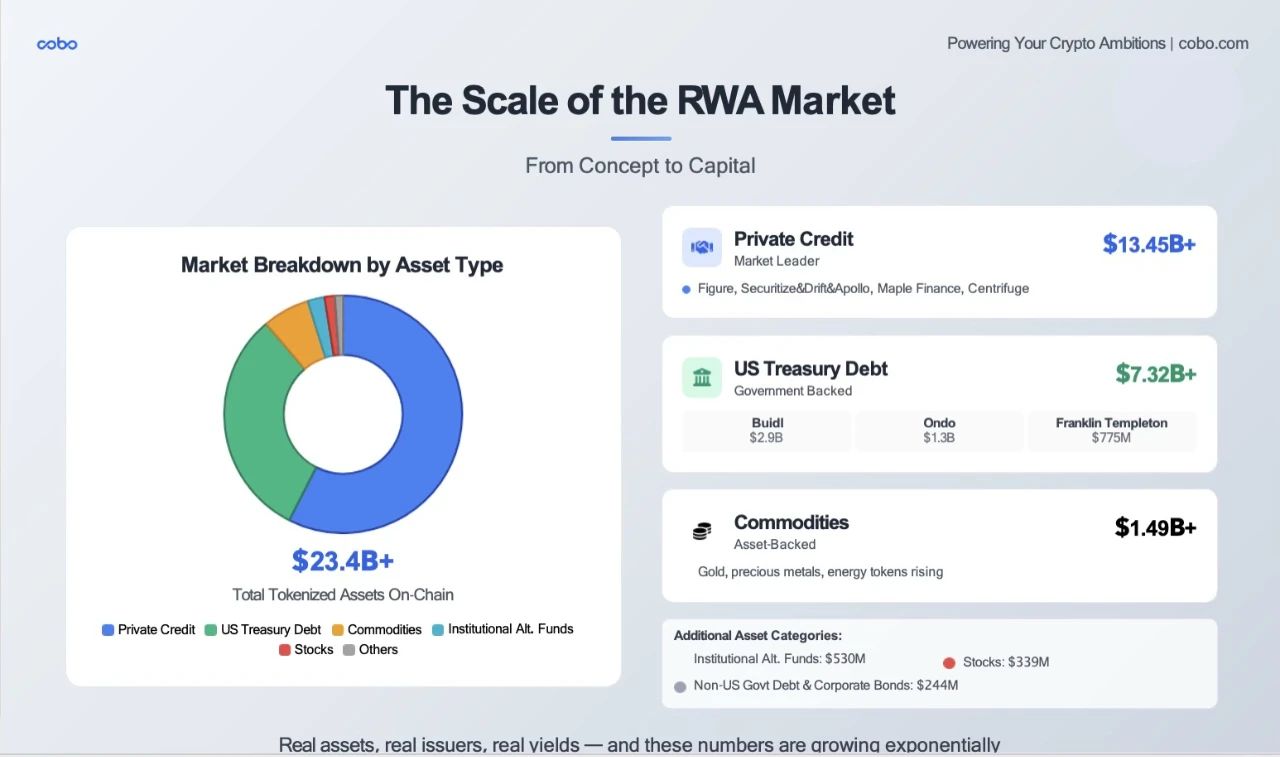
RWA is thriving, and specific market numbers can tell us whether RWA remains a marginal experiment or is trending toward the mainstream.
As of June 9, the total value of tokenized Real World Assets (RWA) on public blockchains has reached nearly $23.4 billion. This is just the traceable portion; on-chain asset products include U.S. Treasury bonds, corporate credit, real estate, various funds, and even commodities. $23.4 billion accounts for about 10% of the stablecoin market and 0.7% of the entire crypto market, ranking 10th or 11th in market capitalization among all tokens.
Further analysis of the data reveals several observations:
💳 The scale of private credit exceeds that of government bonds
The core product of Figure, the largest in scale, is $12 billion (home equity revolving credit, investor mortgages, cash-out refinancing), which has moved institutional-level home loans onto the Provenance blockchain (Cosmos) from loan origination to inter-institutional transfer, completing ownership/yield rights transfer and settlement on-chain. Each loan is minted as a digital eNote and registered in a digital asset registry system, replacing MERS registration and manual custody verification, obtaining on-chain identity, and can be sold, pledged, or securitized instantly. 90-95% of Figure's existing loans are already in the form of on-chain eNotes. This process eliminates paper notes, MERS registration fees, and manual custody verification, reducing friction costs by over 100 basis points per loan and shortening the time for funds to be received from weeks to days.
Securitize has partnered with Drift Protocol to bring Apollo's $1 billion diversified credit fund on-chain.
To date, Maple Finance has issued over $2.5 billion in tokenized loans.
Centrifuge is supporting real-world credit pools for DeFi protocols like Aave and Maker.
🏦 Tokenized government bonds have become a trend
BlackRock's BUIDL fund: with a total management scale of $2.9 billion, currently leading the way.
Ondo's scale is $1.3 billion, and Franklin Templeton's BENJI fund has a tokenization scale of about $775 million.
Matrixdock and Superstate have pushed this category's scale to over $7 billion.
These are not crypto-native experiments but rather mainstream financial institutions utilizing blockchain as infrastructure to settle and distribute government bonds.
🏢 Commodity futures tokenization is an earlier attempt than government bond tokenization, giving it a certain first-mover advantage.
🏢 Funds, including real estate funds, are showing strong momentum in RWA.
In the UAE, MAG Group (one of Dubai's largest developers), MultiBank (the largest financial derivatives trader), and Mavryk (a blockchain technology company) announced a $3 billion collaboration aimed at tokenizing luxury properties.
Platforms like RealT and Parcl in the U.S. are allowing retail investors to purchase fractional shares of income-generating properties—yields are directly distributed to wallets.
These asset tokens are income-generating, tradable, and legally binding assets, making them particularly attractive in today's market environment—they generate income, have low volatility, and are now accessible to stablecoin holders, DAOs, and CFOs of fintech companies.
In summary, we believe that tokenized RWA is no longer just a concept—it has become a market: real assets, real issuers, real yields, and these numbers are compounding growth.
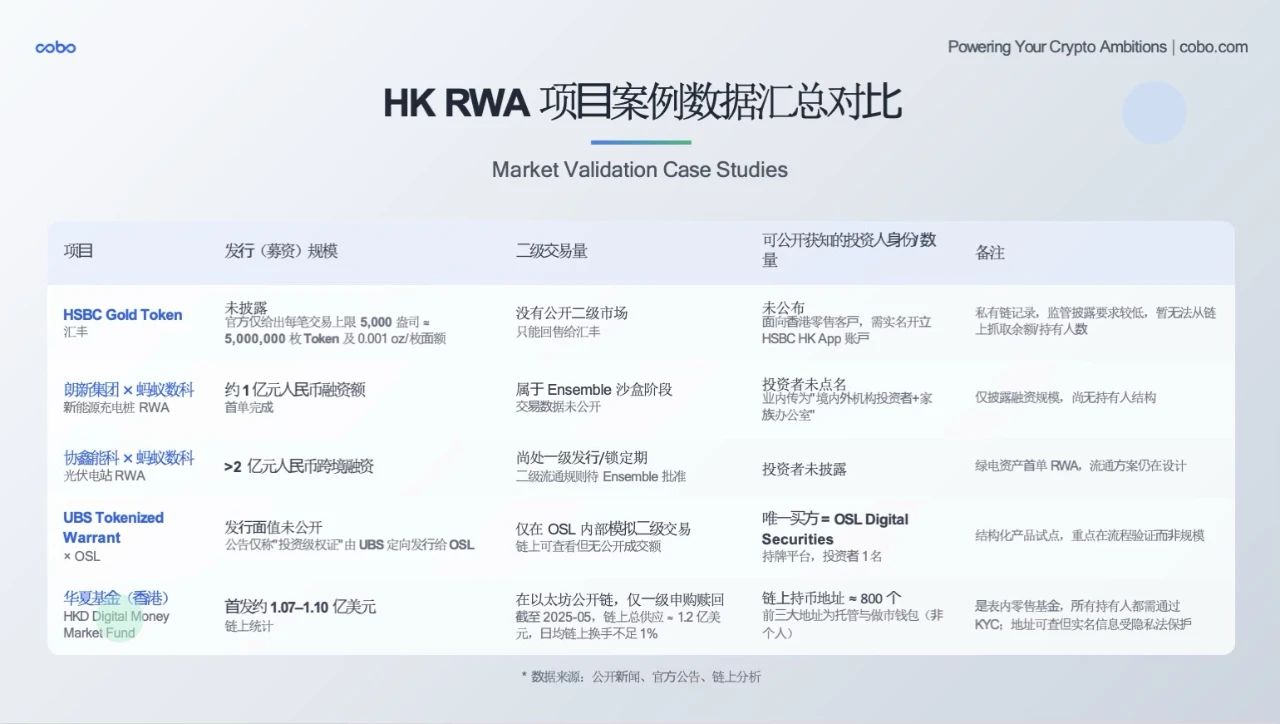
Let's take a look at some specific, real RWA project cases, particularly the RWA practices in Hong Kong and Asia: five representative RWA projects covering different stages and models, from traditional banks to tech companies, from gold to new energy, and from pilot programs to formal operations.
1. HSBC Gold Token
This is a typical case of a traditional bank entering the RWA field.
Key Insight: HSBC chose a private chain, focusing on retail customers while avoiding the complexities of the secondary market.
Strategic Significance: Banks are more concerned with compliance and risk control rather than maximizing liquidity.
Illustrative Issue: Traditional financial institutions may initially choose a closed ecosystem when testing the waters.
2. Longxin Group × Ant Group (New Energy Charging Piles)
This represents China's exploration of RWA in the "new infrastructure" sector.
A financing scale of 100 million RMB demonstrates institutional recognition of the tokenization of real assets.
Key Point: Still in the sandbox phase, indicating that regulation is progressing cautiously.
Investor Composition: Domestic and foreign institutions + family offices, showing interest from cross-border capital.
3. GCL-Poly Energy Photovoltaic Power Station RWA
Larger Scale: Over 200 million RMB, showcasing the appeal of green energy assets.
ESG Concept: Green power assets align with global ESG investment trends.
Circulation Design: Still in the design phase, indicating that the tokenization of complex assets requires more technological and legal innovation.
4. UBS × OSL Tokenized Warrants
Pilot by an International Bank: UBS's participation as a Swiss banking giant is significant.
B2B Model: Targeted issuance to OSL, focusing on process validation rather than scale.
Technical Validation: Emphasis on proving the technical feasibility of tokenized warrants.
5. Huaxia Fund Hong Kong Digital Currency Fund
Most Transparent Case: On the Ethereum public chain, data is fully traceable.
Retail-Oriented: 800 address holders, truly aimed at ordinary investors.
Compliance Balance: Balancing KYC requirements with on-chain transparency.
From these five projects, we can distill a few key terms: private chain, institutional and targeted retail, pilot rather than scale. These projects cover Hong Kong, the mainland, and international backgrounds, presenting a diverse landscape. Specifically, Hong Kong is relatively open and supports innovation; mainland projects are cautiously advancing with sandbox pilots; internationally, major banks are actively testing the waters. The real challenge for these projects is liquidity: most face insufficient secondary market liquidity, which is the current "bottleneck" for RWA.
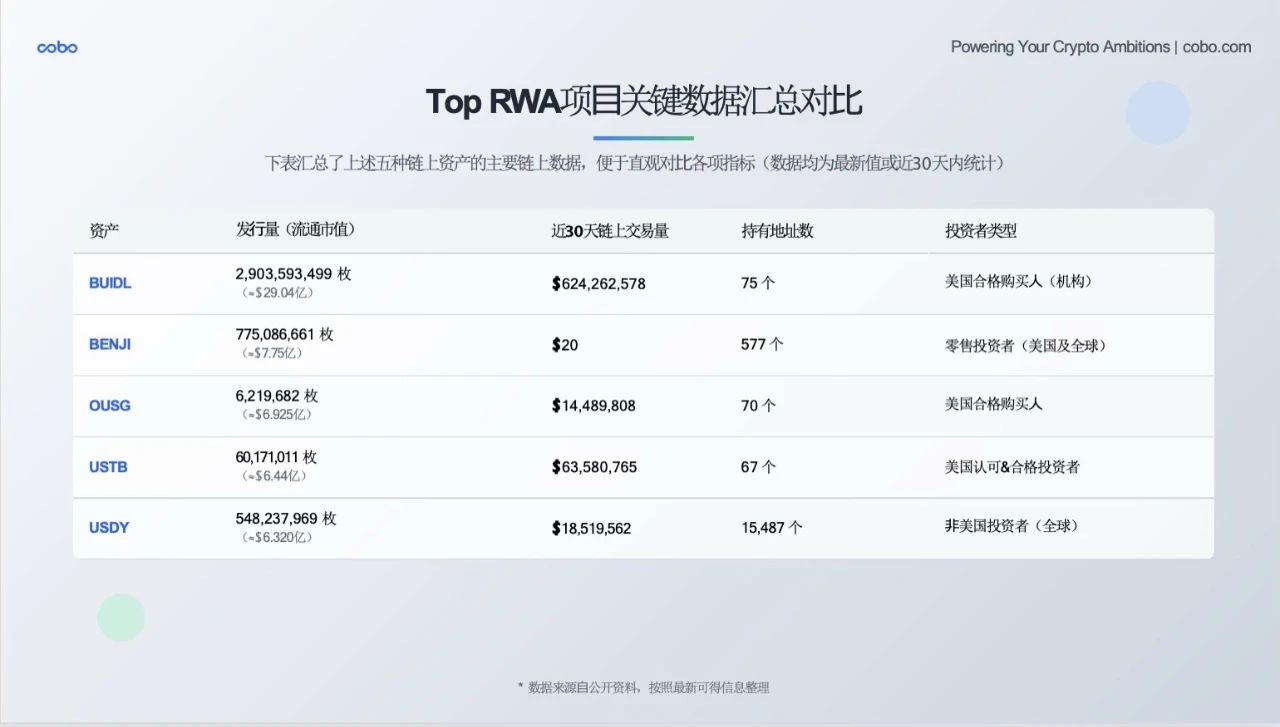
Compared to projects in Hong Kong that are still in the experimental stage, let's observe five leading RWA projects currently operating at scale in the global market, representing the best practices in the market today.
1. BUIDL - BlackRock's Flagship Product
Leading Scale: $2.9 billion, leading all tokenized government bond products.
Institutional Orientation: Only 75 holding addresses, but monthly trading volume reaches $620 million.
Key Insight: On average, each address holds nearly $40 million, demonstrating significant demand from institutional investors.
Strategic Significance: BlackRock has chosen a quality-over-quantity approach, focusing on serving large institutions.
2. BENJI - Franklin Templeton's Retail Experiment
Most Interesting Data: 577 address holders, but 30-day trading volume is only $20.
Retail-Oriented: This is a product truly aimed at ordinary investors.
Liquidity Challenge: Almost no secondary trading, indicating that holders are more "buy and hold," and the holders may not be unfamiliar ordinary people but rather the most familiar ordinary people.
Market Insight: Retail investors may be more concerned with yield than liquidity.
3. OUSG - Ondo Finance's Institutional Product
Balanced Strategy: $690 million scale, 70 addresses, $14 million trading volume.
Institutional Efficiency: Although not as large as BUIDL, trading activity is relatively high.
Clear Positioning: Focused on U.S. qualified investors, avoiding the complexities of retail regulation.
4. USTB - Compliance-Driven Product
Moderate Scale: $640 million, 67 addresses.
High Trading Activity: $63 million in 30-day trading volume shows good liquidity.
Dual Compliance: Aimed at U.S. recognized & qualified investors, with the strictest compliance requirements.
5. USDY - Global Breakthrough
Largest Discovery: 15,487 addresses! This is a truly "mass-market" product.
Global Strategy: Specifically serves non-U.S. investors, avoiding the complexities of U.S. regulation.
Democratized Investment: On average, each address holds only about $40,000, truly achieving inclusive finance.
Through the analysis of international projects, we can derive some core insights and trends: the type of investor determines product design. Institutional products generally have only a few large holders, high unit prices, and low-frequency trading; retail products are mostly held by individual investors, with low unit prices and a focus on holding; while global products emphasize avoiding regulatory complexities through geographical differentiation.
In summary, from the current RWA projects in Hong Kong and the international market, we can draw several observational conclusions:
No single model fits all markets: Institutional and retail markets require completely different product designs.
Regulation is the biggest dividing line: There is a significant performance difference between products for U.S. and non-U.S. investors, with U.S. professional investors having a clear advantage in liquidity.
Liquidity remains a challenge: Even the most successful products do not have high secondary market activity.
Scaling is key: Either go deep (large institutional amounts) or go wide (retail penetration).
These data and analyses reveal an important reality: successful RWA products need to find their own liquidity and unique product-market fit.
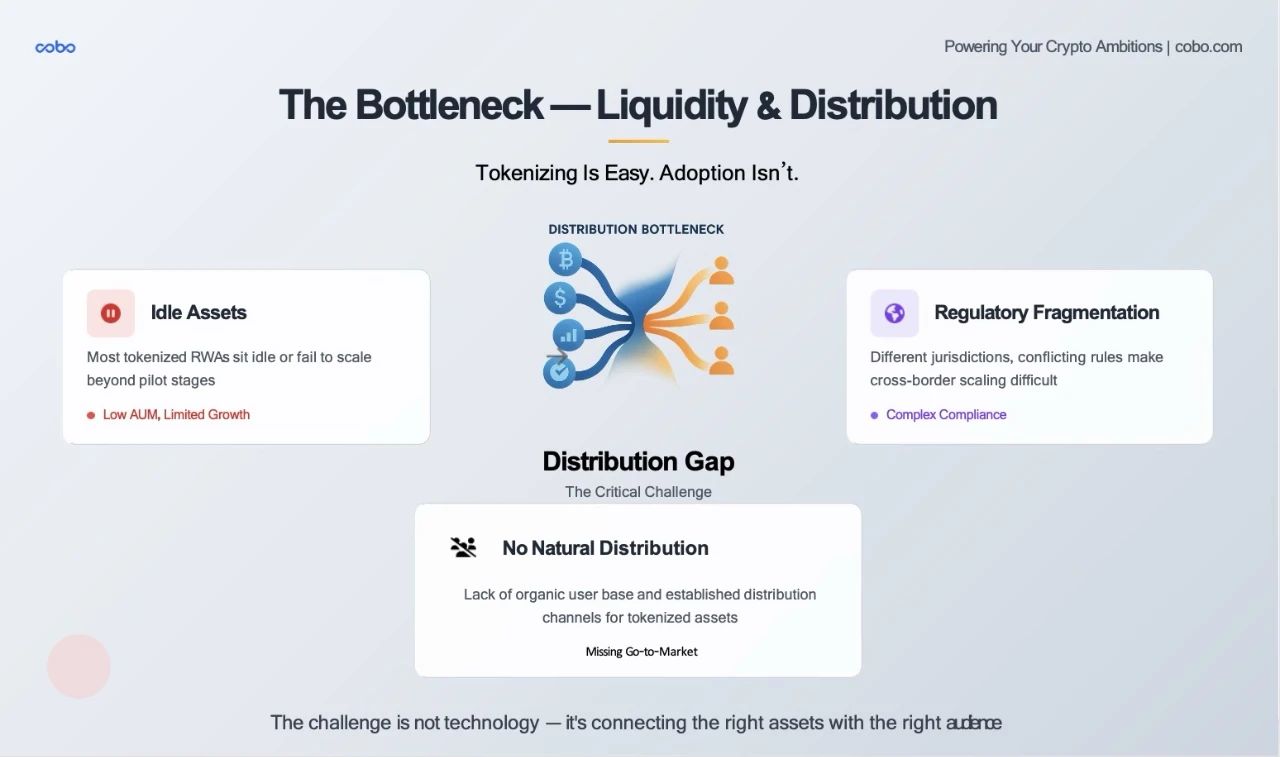
Tokenization of RWA is easy, but distribution is difficult. Anyone can mint a token representing a piece of real estate or a U.S. Treasury bond. The real challenge is how to deliver these tokens at scale, compliantly, and continuously to the right buyers.
In addition to the leading RWA projects we have seen, there are currently dozens of tokenized government bond products on-chain, many of which offer attractive yields, but most have asset under management (AUM) of less than a few million dollars. Why? Because they have not been integrated into DeFi protocols, are not listed on regulated exchanges, and institutional buyers cannot easily access them without customized onboarding processes.
The value of tokenized assets directly depends on the ease of exit. Currently, apart from a few pools like Maple or Centrifuge, the secondary market liquidity for RWA is very weak. One reason is that RWA does not yet have a market like Nasdaq, or even a decent bond market. This also leads to pricing opacity, which limits institutional participation.
Finally, the fragmented regulation of RWA remains a significant obstacle. Each jurisdiction has different views on whether tokens are securities, how they should be custodied, and who can hold them. This is slowing down the cross-border scaling process of RWA, particularly in Asia.
Therefore, we see that the quality of RWA assets is improving, and the infrastructure is becoming increasingly robust, but the "last mile" has not yet been bridged: how to match tokenized assets with the right capital, establish liquidity, and truly make RWA work.
This is the challenge facing the current RWA industry, and it is also the greatest opportunity.
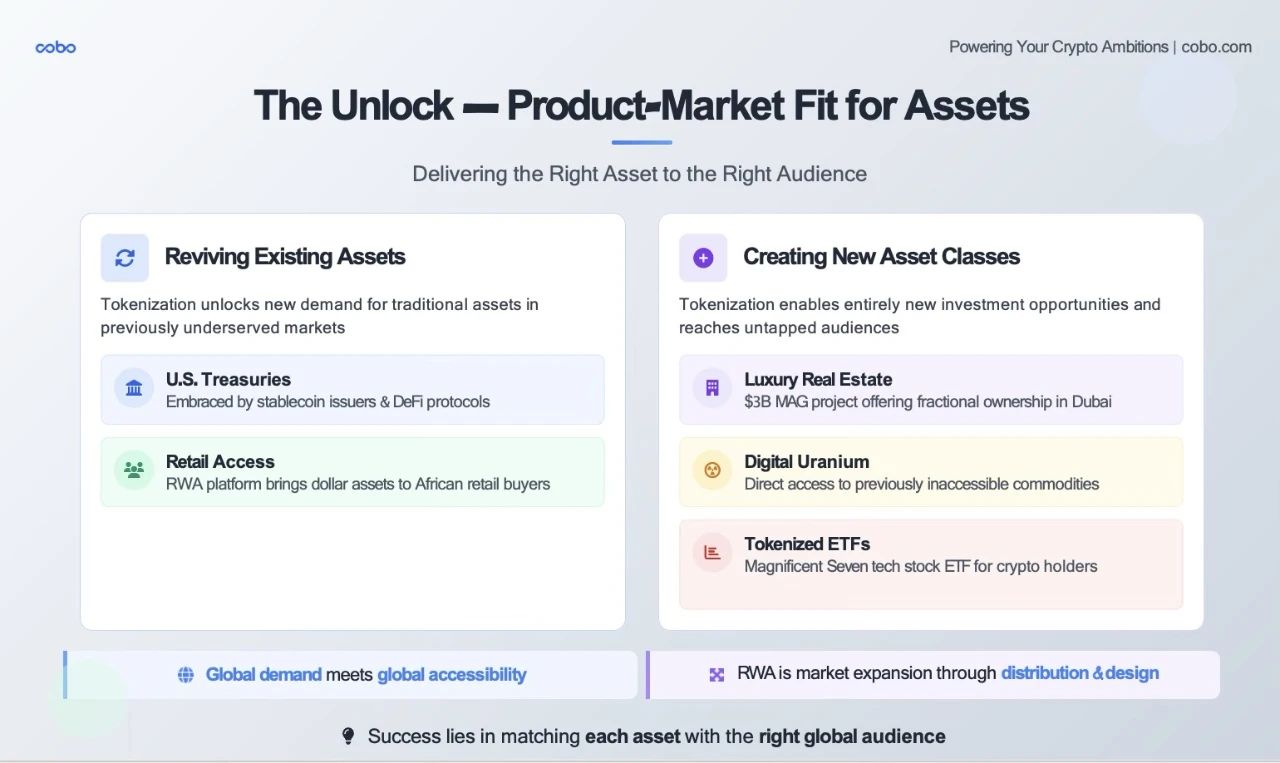
To solve this liquidity problem, the real breakthrough lies not just in better infrastructure, but in the fit between products and markets. It is not simply about putting old traditional assets onto a new blockchain track; the core question is: who really needs this asset? If this asset becomes easier to access, what new markets can it serve? If U.S. stocks traded 24/7, and more and more brokerages could buy and sell digital assets, would there still be demand for tokenized ETFs and U.S. stock trading?
Tokenization can do two very powerful things: first, it can find new demand for existing assets that are stagnating in traditional markets; second, it can create entirely new investable assets and deliver them to investors who have never been able to participate before.
Reigniting Demand: The current hot asset, U.S. Treasury bonds, is such a case. In the traditional financial market, the U.S. Treasury market is becoming crowded and less attractive. However, in the crypto world and emerging markets, they have gained new opportunities: on-chain stablecoin issuers are utilizing tokenized Treasury bonds to obtain on-chain yields. Blockchain platforms designed specifically for RWA have directly sold U.S. Treasury bonds to retail investors in Africa, allowing these retail investors to access dollar-denominated, yield-bearing assets that local banks have never provided. In this case, tokenization is not just about digitizing assets—it also matches assets with a global audience that craves safety and yield and has been underserved.
Innovating New Investable Assets: When tokenization creates new assets, this presents even more exciting opportunities.
Case 1: Luxury Real Estate in Dubai
The price increase of Dubai real estate in recent years has caught the attention of many overseas investors. However, how many investors can truly enter this market? First, do investors need to fly to Dubai? Secondly, you need a reliable real estate agent. Unfortunately, they are not available during the day. Traditionally, this market has been closed—opaque, with high barriers to entry, making it difficult for foreigners to access. Now, through tokenization, projects like the $3 billion MAG project are opening up fractional ownership of high-end properties to global buyers—equipped with compliance, yield, and liquidity pathways. In this model, could the phenomenon of Shanghai residents buying properties in Japan after the pandemic be replicated in Dubai? Here, we see that the tokenization of new assets is not just about financial inclusion—it is about market expansion.
Case 2: Commodities like Uranium
Most retail investors have never engaged with uranium—it is too complex, too restricted, and too niche. However, with the new tokenization tool "Digital Uranium," investors can now directly invest in this key resource that powers the global nuclear energy transition. A brand new asset—delivered to a brand new audience—becomes investable through tokenization.
Case 3: Stocks are also being restructured.
When the crypto market is sluggish, tokenized ETFs of the Nasdaq's Magnificent Seven provide traders seeking real-world returns without exiting cryptocurrency. In other words, tokenization allows assets to follow the flow of funds, rather than the other way around.
Case 4: Private Credit
The tightening of spreads in traditional financial markets has put lenders in a wait-and-see mode. Platforms like Maple and Goldfinch are leveraging tokenization to provide funding for small and medium-sized enterprises (SMEs) in underbanked areas, while allowing global DeFi users to earn yields from real-world cash flows.
Thus, the bigger picture of RWA should be this: tokenization is not just about repackaging old financial instruments; it is about redefining what can become an asset—and putting it in the hands of those who value it most. This is what "product-market fit" looks like in the on-chain era: global demand meets global accessibility, new assets meet new liquidity, and finding the right match between products and markets.
These new audiences—including institutional investors, finance departments of fintech companies, and crypto-native investors—actually span two domains. Some are in traditional finance, while others are native to DeFi. For RWA to truly achieve large-scale development, the only way is to build a bridge between the two. It can be understood this way: traditional finance (TradFi) brings assets—including credibility, compliance, and scale; decentralized finance (DeFi) brings distribution—24/7 access, smart contract automation, and global liquidity. The opportunity lies in how to connect the two securely, compliantly, and programmatically.
This is not just theoretical; it is happening: Ondo Finance is bringing BlackRock's tokenized government bonds on-chain and connecting them to DeFi vaults; Centrifuge is converting off-chain credit into on-chain assets for protocols like MakerDAO and Aave; Maple and Goldfinch enable institutional lenders to access global yield-seeking funds through DeFi channels. These examples demonstrate the sparks that can fly when traditional financial assets meet DeFi liquidity.
Having understood the trend opportunities and confirmed the direction, what we need is the right tools to participate in this RWA boom. This is where Cobo comes in: Cobo provides end-to-end infrastructure for tokenized assets, whether for asset issuers, funds, or securities firms, helping you safely and compliantly bring real-world assets on-chain.
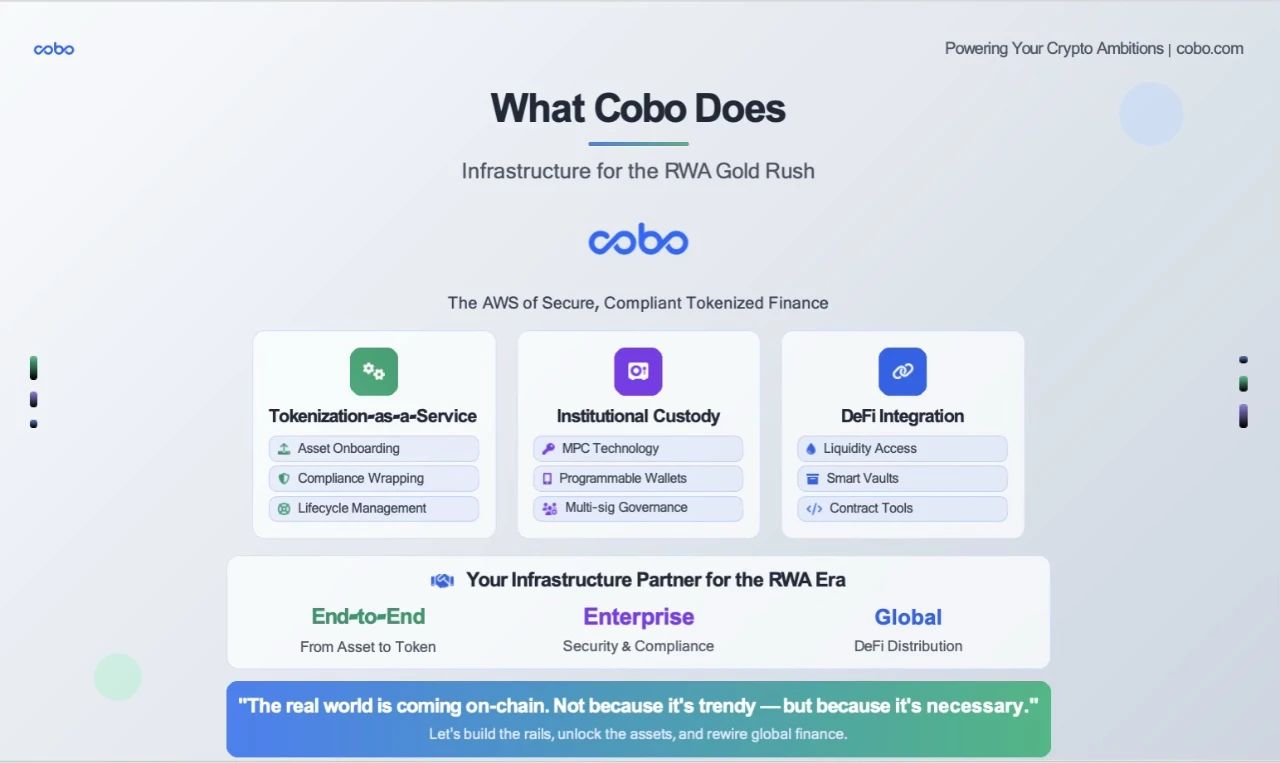
Specifically, we do this:
🛠️ Tokenization as a Service
We help you connect various assets such as government bonds, credit, and real estate to the platform and package them through smart contracts.
You can choose the chain, compliance framework, and access permissions.
We handle the technology, legal structure, and full lifecycle management.
🔐 Institutional-Grade Custody
Cobo is a qualified custodian regulated by authorities.
Our MPC (Multi-Party Computation) wallet technology stack provides you with security, automation, and complete control—no need for mnemonic phrases, eliminating single points of failure.
We support whitelisted transfers, time-locked vaults, and multi-signature governance—all the security features you need to ensure tokenized assets are safe and sound.
🌉 DeFi Integration
We don’t just package your assets; we also provide tools for distribution and interaction.
Whether you want to connect to Aave, provide staking services, or establish liquidity pools—we can distribute and interact with the necessary institutional wallets, such as Web3 wallets and MPC wallets, that can directly interact with the blockchain.
You can think of Cobo as the middleware layer between traditional assets and on-chain liquidity. From asset connection to custody, from compliance management to role-based authorization, to interaction with the blockchain in a risk-controlled environment, Cobo is your infrastructure partner, helping you establish and expand your business in this new market.
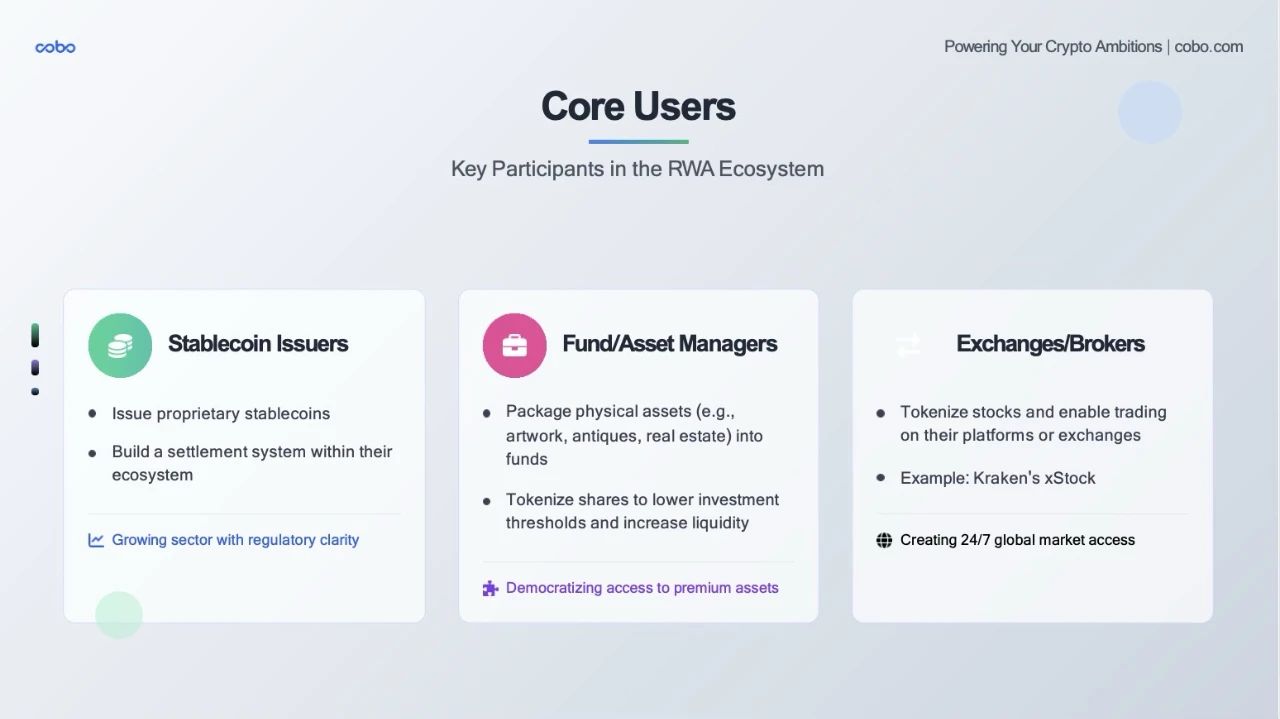
Our RWA Engine can serve all stablecoin issuers, asset managers, and institutions similar to exchanges.
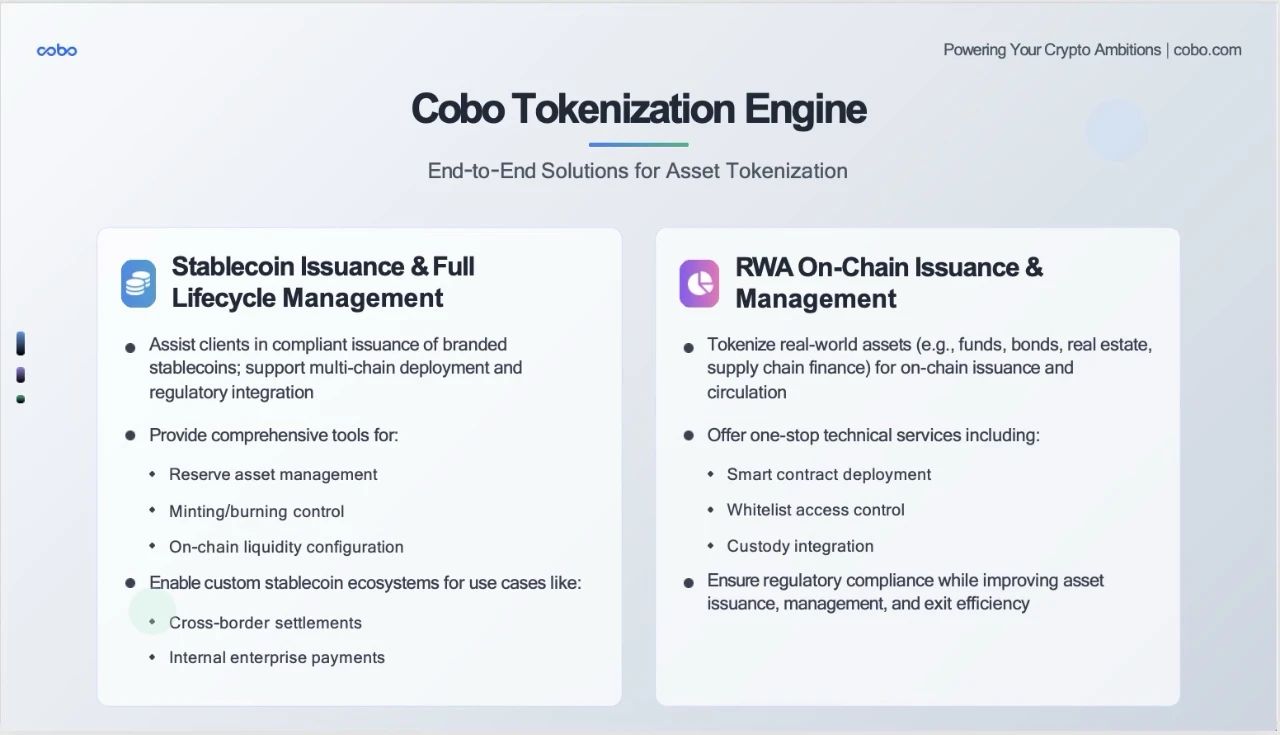
Cobo Tokenization Engine is our core technology engine built for the RWA era. We do not simply provide a single tool; we have constructed two complete end-to-end solutions covering the two most important tracks in the tokenization field.
Left Side: Stablecoin Issuance and Full Lifecycle Management
In our interactions with clients, we found that many institutions wish to issue their own branded stablecoins but face three major challenges:
High technical barriers: smart contract development, multi-chain deployment
Complex compliance: regulatory requirements across different jurisdictions
Operational difficulties: reserve management, liquidity allocation
Cobo's Solution
We provide not just technical tools but a complete ecosystem:
Compliant Issuance: Helping clients issue branded stablecoins in compliance with local regulatory requirements.
Multi-Chain Deployment: A single system supporting multiple mainstream blockchains like Ethereum, BSC, and Polygon.
Comprehensive Toolkit:
Reserve asset management: real-time monitoring, automated reporting
Minting/burning control: precise supply management
On-chain liquidity allocation: deep integration with mainstream DEXs and CEXs
Application Scenarios Showcase
Cross-Border Settlement: Enterprises can issue their own stablecoins for international trade settlements.
Internal Corporate Payments: Large groups can use it for internal transfers and employee compensation.
Right Side: RWA On-Chain Issuance and Management
The data we just saw—$29 billion from BUIDL, $12 million from Huaxia Fund—demonstrates the enormous potential of the RWA market. However, to truly scale, industrial-grade infrastructure is needed. We provide RWA issuers with a true "plug-and-play" solution:
Smart Contract Deployment: Audited, modular contract templates
Whitelisted Access Control: Precise permission management to meet different regulatory requirements
Custody Integration: Seamless integration with our custody, MPC wallets, and Hong Kong trust companies
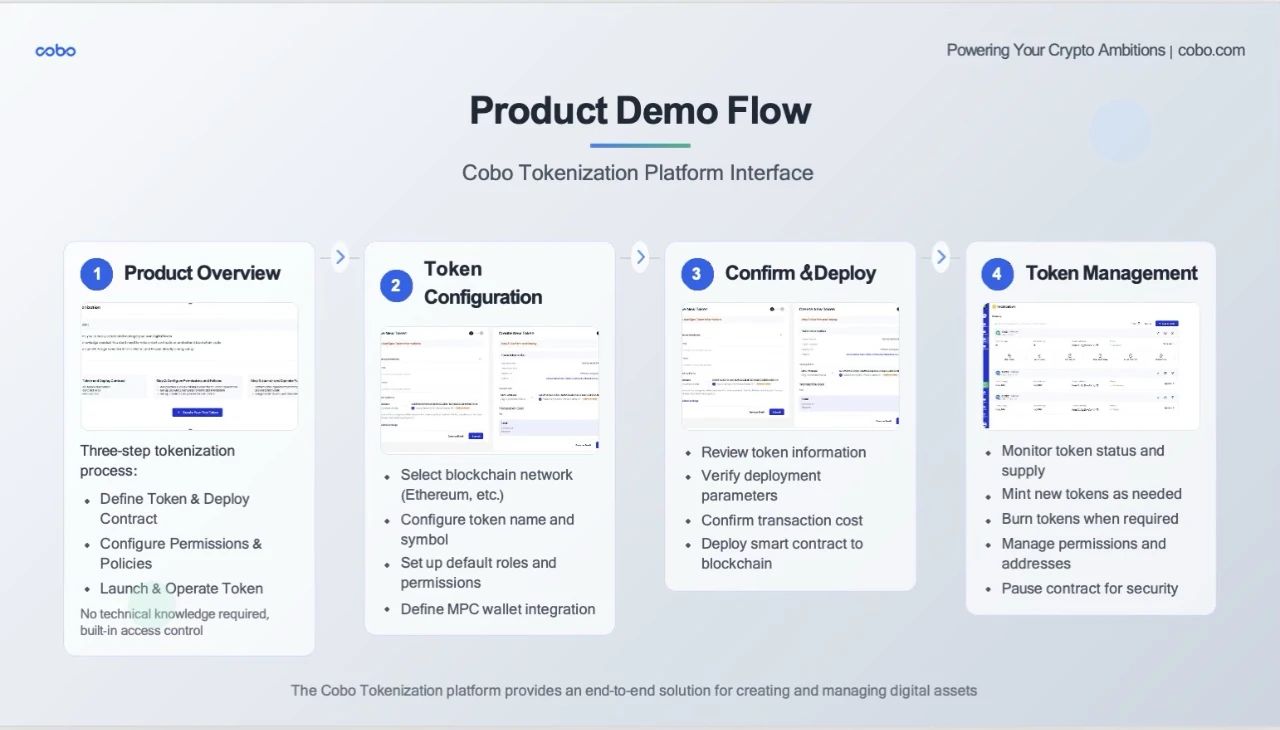
Here is a real user interface and operation process of our tokenization platform.
Step 1: Product Review
This is the first interface users see.
• Three-step process clearly displayed: Define token & deploy contract, configure permissions & policies, launch & operate token.
• No technical barrier commitment: The interface clearly states "No technical knowledge required."
• One-click start: Lowering the user entry barrier.
Step 2: Token Configuration
This shows the actual configuration interface:
• Blockchain selection: Users can choose different blockchains like Ethereum mainnet.
• Basic token information: Necessary information such as name, symbol, etc.
• Security settings: MPC wallet integration to ensure asset security.
• Custom settings: Meeting different clients' personalized needs.
Step 3: Confirm & Deploy
This is the critical confirmation stage:
• Information verification: All parameters are clear at a glance.
• Cost transparency: Clearly displays deployment fee ($0.99).
• MPC wallet display: Showcasing our core security technology.
• Final confirmation: Giving users a last chance to check.
Step 4: Token Management
This is the management interface after deployment:
• Multi-token management: Supporting simultaneous management of multiple token projects.
• Status monitoring: Different statuses such as Success, Processing, Failed are clearly displayed.
• Rich functionality: Complete features such as minting, burning, permission management, contract pausing, etc.
• Detailed data: Key information such as total supply, individual holdings, contract address, etc.
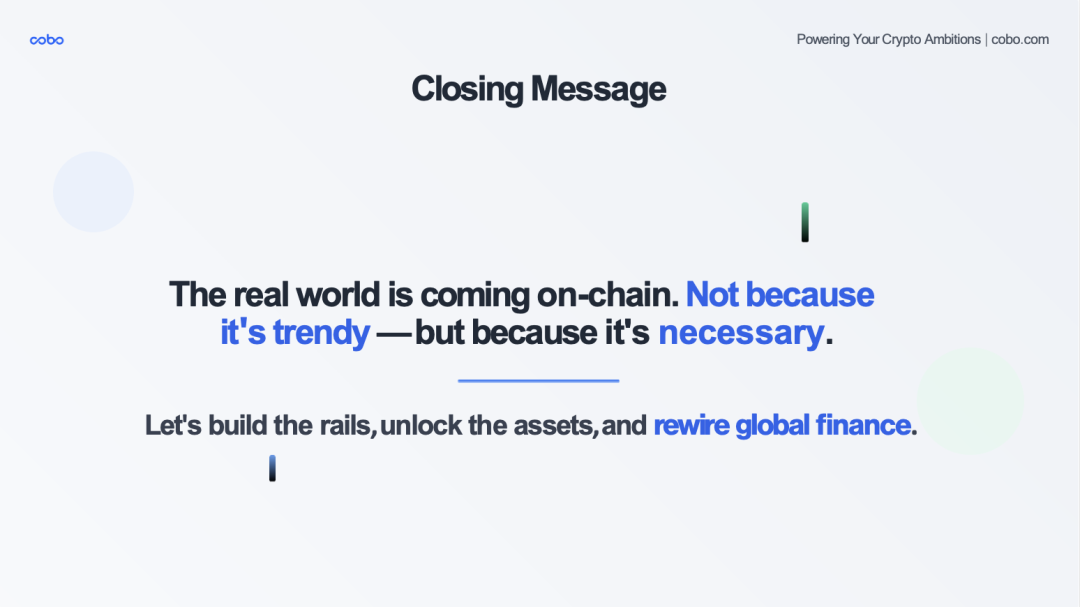
Today we discussed a lot of content—from market trends to technical architecture, from specific cases to product demonstrations. But I want to summarize today's core point with one sentence:
First Sentence: The Inevitability of Reality—The Irreversibility of Tokenization;
Second Sentence: The Essence of Motivation - RWA is not about blockchain being cool or tokenization being trendy. It is about the limitations of the traditional financial system—geographical boundaries, time constraints, high costs, and complex processes—these issues must be addressed;
Third Sentence: The Call to Action. Asset providers need to bring high-quality real-world assets; technology providers need to offer reliable infrastructure (this is our role); investors: provide liquidity and trust; regulators: provide a compliance framework.
This window will not remain open forever. Early participants will reap the greatest rewards—not only economic benefits but also the opportunity to shape the future financial system.
About Cobo
Cobo is a trusted leader in digital asset custody and wallet technology, providing a one-stop wallet technology platform that enables institutions and developers to easily build, automate, and securely scale their digital asset businesses.
Founded in 2017 by blockchain pioneers and headquartered in Singapore, Cobo is trusted by over 500 leading digital asset companies globally, with assets under custody reaching billions of dollars. Today, Cobo offers the industry's only platform that integrates four different digital asset wallet technologies: custody wallets, MPC wallets, smart contract wallets, and exchange wallets. Cobo is committed to the highest security standards and regulatory compliance, maintaining a zero-incident record to date, and has obtained ISO 27001, SOC2 (Type 1 and Type 2) certifications, as well as licenses in multiple jurisdictions. With industry-leading innovations, Cobo has received recognition from authoritative organizations such as Hedgeweek and Global Custodian.
For more information, please visit: www.cobo.com.
免责声明:本文章仅代表作者个人观点,不代表本平台的立场和观点。本文章仅供信息分享,不构成对任何人的任何投资建议。用户与作者之间的任何争议,与本平台无关。如网页中刊载的文章或图片涉及侵权,请提供相关的权利证明和身份证明发送邮件到support@aicoin.com,本平台相关工作人员将会进行核查。




